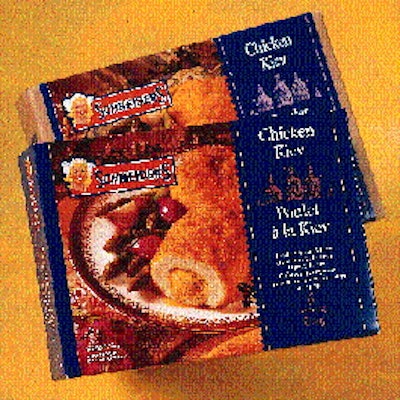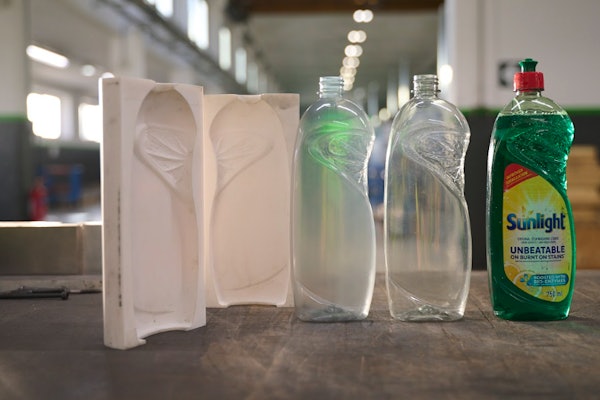While single-face laminating technology has been used for close to a decade, only in the last couple of years has demand for it begun to accelerate. As a replacement for laminating spot labels to double-faced corrugated, single-faced laminating eliminates an entire layer of paper. Instead, the "label" is replaced by a litho-printed liner that's laminated directly to the corrugated medium as a full sheet, providing 100% print coverage. Single-faced laminating combined with fine F-flute corrugated is attractive because it combines the graphic appeal of folding cartons with the strength of corrugated. One packager who had to choose between paperboard and single-faced corrugated was Canadian meat packer J.M. Schneider, Inc., Kitchener, Ontario. It had been selling frozen prepared meat and poultry in 13/4- to 3-lb portions in 150#-test, E-flute double-wall corrugated containers with spot litho labels. In addition to packing about 30 SKUs of its own meat products-sold across Canada at club stores and groceries-the company also produces meat products for private-label accounts. After experiencing sharp price hikes in corrugated, the company evaluated alternative forms of packaging to keep costs in check. It considered switching to paperboard folding cartons; ultimately, it selected a single-faced laminated F-flute box from its existing corrugated supplier, Image Pac (Toronto, Ontario, Canada), the specialty packaging division of MacMillan Bathurst (Mississauga, Ontario, Canada). Although the litho printing process is the same, the "labels" now cover 100% of the box exterior, providing a more polished retail look. Faster boxmaking The new box was made possible by Image Pac's recently installed $3.7 million (Canadian) single-faced laminator at its Toronto plant. The machine is one of just three in the entire country, according to Image Pac sales manager Rick Depelsmaeker. It allows Image Pac to laminate sheets or a continuous web to single-faced corrugated as small as F-flute. To manufacture the old box, Image Pac produced double-faced corrugated E-flute, then ran it through a one-color flexo post-print operation for copy that appeared on the sides and back of the old box. The labels-from other suppliers-then had to be die-cut and laminated to the liner. While spot labels could only be applied at 1ꯠ to 1귔 labels/hr, the new laminator runs at 6ꯠ to 7ꯠ boxes/hr. "With the new laminator, we corrugate and laminate in one operation," says Depelsmaeker. "It makes a world of difference as far as productivity goes," he adds. Also eliminated is the need for flexo post-printing, since the printed liner provides 100% box coverage. After boxes are laminated, they are die-cut and four-corner glued (as before) to form Image Pac's Fastpak(TM) boxes, its version of a one-piece folder. Designed for fast manual set-up, the boxes resemble a telescoping box except that the lid is attached to the base on the back side. The box style itself hasn't changed from the old package to the new. Schneider managed to reduce the size of some boxes-but not the product quantity-to reduce material usage, which accounts for some cost savings. The boxes are shipped flat to each of Schneider's four plants where they are hand-erected and filled. Boxes are then closed and sealed with two L-clips of filament tape. The new box did not affect the packaging process. Competes with chipboard While paperboard and single-faced laminating both offer the same graphic impact, Schneider found that laminating offered a cost advantage for shorter runs. "Obviously paperboard's still cheaper when you're in the larger runs," says Gary Dinkel, Schneiders's senior buyer. "But you don't always have the flexibility of larger runs. We have some customers who might only use 10ꯠ or 20ꯠ boxes a year. Running chipboard in those quantities will send costs through the roof." The short-run flexibility is actually a trick that's made possible by the breadth of Schneider's product line and Image Pac's willingness to carry two or three months' worth of printed liner inventory. "If Schneider's short on a package or needs quick turnaround, as long as we've got printed labels, we can produce it," explains Depelsmaeker. "Of course, our label printer is pretty good at turning things around, too. They can go to press on a new or modified label within a couple of days, ganging that print run with maybe three or four other brands that run all the time." Carton strength was another consideration. "We've heard different views as to how well paperboard stands up in the marketplace," says Dinkel. "We're hearing that some of our competitors who went to paperboard are coming back to corrugated." How does F-flute perform for Schneider versus its previous E-flute box? "It's comparable," says Dinkel, who has received no damage reports for the new boxes. "We ship in a master pack anyway," he says. The carton is said to be slightly lighter than the previous E-flute box, though Schneider, which ships largely via its own fleet, hasn't noticed any freight savings. Freight costs on incoming boxes, however, are reduced since a greater number of boxes fit on a pallet than before. Printing didn't change The linerboard is still offset-printed by the same contingent of suppliers that printed the label; flexo-printed labels that were used on some boxes will be eliminated once the changeover is completed. Graphics were designed in-house by Schneider. What has changed is the width of the sheet; the job is now run on a 60" press versus a 40" previously, due to the larger graphic area required by the label. As before, images are printed three up. "We've probably lost a little efficiency in the printing process [due to the extra paper being consumed]," says Depelsmaeker, "but we've offset it by the efficiencies that we pick up with the laminator." The linerboard label is Image Pac's 8-pt clay-coated board, printed in five colors plus a standard press varnish, according to Depelsmaeker. Although Schneider likes the look of the full coverage printing, it was by no means unhappy with the old label, Dinkel points out. "Initially, the thinking was that we're in what we call the boxed meat field, consisting of larger size packs. As a result, we had wanted our package to look something like a kraft box. But now that the economics are so significantly different, we had to look at bringing our costs down. And the newer package is slicker, glossier and nicer looking." Schneider wouldn't disclose specific savings figures. At press time, six box designs had switched over since the changeover started in February, and the rest are slated to follow as old inventory is depleted. Since the new containers have just launched, it's too early to tell the impact on sales. But the benefits are already being felt in Dinkel's purchasing department. "Our packaging costs were really hurting us," sums up Dinkel. "This was a process where we could still come out with the same strength box, while lowering our costs."
























